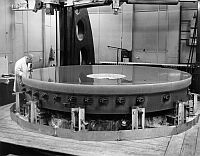 | |||
|
| Home > Public Information > William Herschel Telescope > The Optics |
William Herschel
Telescope
Telescope Optics
|
The William Herschel Telescope is
of classical Cassegrain optical configuration. The paraboloidal primary
mirror is made of a glass-ceramic material (Cervit) having near-zero coefficient
of expansion over the operating temperature range. It has a clear aperture
of 4.2 m and a focal length of 10.5 m (f/2.5). Its diameter-to-thickness
ratio of 8 makes it thinner than for most large telescopes at the time
it was built, but it is not classifiable as a thin mirror and raises no
special problems for its support system (dimensions of primary mirror). The mirror is a solid piece, with no empty cells to reduce the weight.
The precise diameter of 4.2 m
was determined by the availability of the mirror blank, made by Owens-Illinois.
The mirror was figured at Grubb Parsons. It was believed that this was
the most accurate large mirror yet made, concentrating 85% of the light
of a distant star into an area only 0.3 arc sec in diameter. It is necessary
for the mirror to be very smooth and accurate on scales of 20 cm or less,
since this is about the size of the atmospheric cells above La Palma site.
Portions on the mirror separated by larger distances than this may be tilted
relative to one another so long as they direct the light within the 0.3
arc sec tolerance. Thus, the mirror is accurate to within 1/50 of the wavelength
of light at a scale of 2 cm, about 1/15 wavelength at 8 cm and about 1/2
wavelength at 1 m or more.
The primary mirror weighs 16.5 tonnes and the diametre of the central obstruction is 1.21 m. The mirror surface is aluminium, and when fresh reflects about 85% of the light falling on it. The primary mirror suffers particularly from exposure to the elements (humidity, pollen, dust, etc.) and it is realuminised once every year. This involves removing the mirror cell from the telescope, lowering the mirror to the ground floor, washing off the old surface with caustic soda and resurfacing in a large vacuum tank. The focus of the uncorrected primary mirror would show strong coma off-axis but the incorporation of a three element correcting lens before the prime focus gives an unvignetted field of 40 arc min diameter extending to 60 arc min diameter at nominally 0.6 transmission. The effective local ratio of the primary mirror with corrector is f/2.8. When not operating at prime focus, a convex hyperboloidal secondary mirror, made of Zerodur, 1.0 m in diameter, directs the light through a central hole in the primary mirror to the main instrumentation mounted at the Cassegrain focus beneath the primary mirror cell. The telescope also incorporates a third main mirror, a flat, angled at 45 degrees, which can be motor-driven into position at the intersection of the axes, just above the primary mirror, so that the light from the secondary is diverted sideways either through one of the altitude bearings to the Nasmyth platforms where particularly large or massive instruments can be placed, or to an intermediate, folded Cassegrain position for use of small, subsidiary instruments. As desired during the night, instruments mounted at any of these four stations can be selected within minutes by the motion of the single Nasmyth flat mirror. The effective focal length of the telescope for the Cassegrain and Nasmyth foci is 46.2 m (f/11). The available unvignetted field diameters are 15 arc min at the direct Cassegrain focus and 5 arc min at the Nasmyth and folded Cassegrain foci. More information can be found at section WHT optics of the Observers' Guide (obsolete, but most of the figures and tables are still valid). |
| Top | Back |
|


